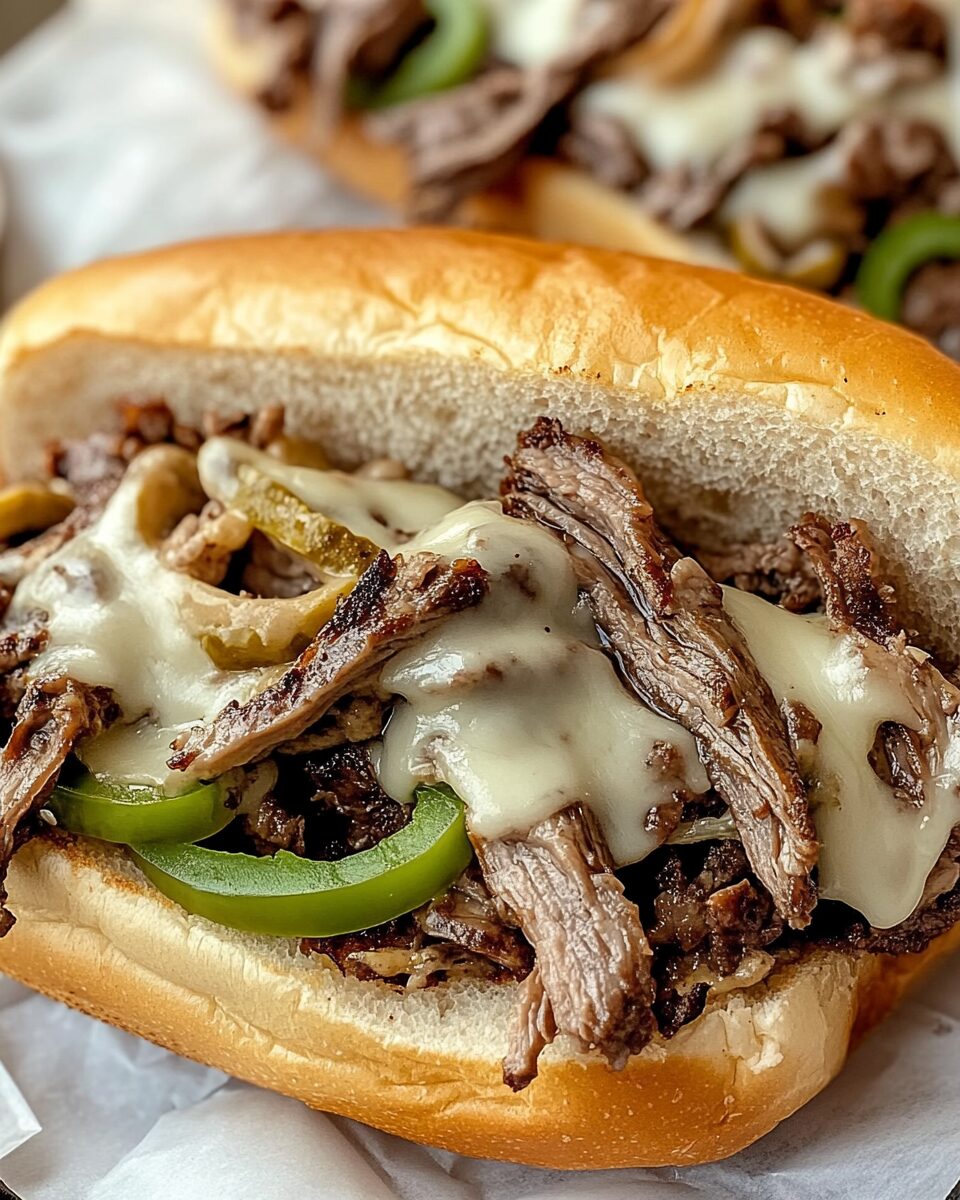The Philly Cheesesteak is more than just a sandwich—it’s a celebration of tender ribeye, sautéed peppers and onions, and creamy provolone cheese all wrapped in a warm hoagie roll. This dish originated in Philadelphia but has become an American icon, loved for its savory, satisfying flavor.
Whether you’re feeding a hungry family or just looking for a quick and filling dinner, this recipe is a surefire hit. The combo of sizzling steak, melty cheese, and fresh bread creates a delicious harmony in every bite. It’s a one-pan wonder that brings steakhouse quality to your home kitchen in under 30 minutes.
Full Recipe
Ingredients:
-
1 lb ribeye steak, thinly sliced
-
1 tablespoon vegetable oil
-
1 green bell pepper, sliced
-
1 small onion, sliced
-
1/2 teaspoon garlic powder
-
Salt and pepper to taste
-
4 hoagie rolls
-
8 slices provolone cheese
Directions:
-
In a large skillet, heat the vegetable oil over medium-high heat.
-
Add the sliced onions and green peppers. Sauté for 5–7 minutes until softened and lightly caramelized.
-
Push the veggies to one side of the skillet and add the thinly sliced ribeye steak to the other side.
-
Season the steak with salt, pepper, and garlic powder, cooking until browned—about 3–5 minutes.
-
Mix the steak with the cooked peppers and onions in the skillet.
-
Divide the mixture into four portions in the pan, then top each with 2 slices of provolone cheese. Cover the pan for 1 minute to melt the cheese.
-
Toast hoagie rolls if desired. Scoop one portion of the cheesy steak mixture into each roll.
-
Serve immediately while hot and melty.
Prep Time: 10 minutes | Cooking Time: 15 minutes | Total Time: 25 minutes
Kcal: 530 kcal | Servings: 4 servings
The History of the Philly Cheesesteak
The Philly Cheesesteak is more than just a sandwich—it’s a deeply rooted cultural icon born in the heart of Philadelphia, Pennsylvania. This now-famous creation dates back to the 1930s when brothers Pat and Harry Olivieri are said to have invented it. Initially, it was just thinly sliced beef cooked on a grill and served in an Italian roll, but it quickly gained popularity as people started requesting the addition of cheese. Thus, the cheesesteak was born.
What makes this sandwich so legendary isn’t just its origin but its enduring legacy. It represents the spirit of American comfort food: bold, indulgent, and made with love. Across the United States, Philly Cheesesteaks have become staples at food trucks, diners, sports stadiums, and family tables alike.
What Makes a Cheesesteak Truly “Philly”?
While many places have adapted their own versions of the cheesesteak, the “Philly” in Philly Cheesesteak means something very specific to locals. A traditional Philly Cheesesteak is made with thinly sliced ribeye steak, melted cheese (often provolone, American, or Cheese Whiz), and served on a long hoagie roll. It’s not just about the ingredients—it’s about the simplicity, the balance of flavors, and the texture contrast between the soft bread, tender beef, and gooey cheese.
Peppers and onions are a commonly accepted (though not universally used) addition, offering a pop of color and sweet-savory flavor that pairs beautifully with the meat and cheese. But the base of the sandwich remains focused on the harmony between steak and cheese.
Meat Matters: Choosing the Right Cut
The choice of steak is critical in this recipe. Ribeye is the gold standard due to its marbling and tenderness. When thinly sliced and seared quickly on a hot griddle or skillet, ribeye develops a rich, savory flavor while staying juicy and melt-in-your-mouth tender.
Other cuts can be used—such as sirloin or flank steak—but none quite replicate the depth of flavor that ribeye brings to the sandwich. The key is slicing the meat as thinly as possible, which allows it to cook quickly and evenly, enhancing the overall texture of the sandwich.
The Cheese Debate: Provolone, American, or Whiz?
Cheese choice is often a topic of heated debate among Philly Cheesesteak fans. Each option brings a unique twist to the sandwich:
-
Provolone offers a mild, nutty taste that melts into the steak without overpowering it.
-
American cheese is creamier and adds a richer mouthfeel.
-
Cheese Whiz, the most controversial choice, is actually beloved by many locals for its nostalgic, processed cheesiness that coats every bite.
In this recipe, provolone is the cheese of choice because it strikes a perfect balance—it melts smoothly and enhances the flavor of the steak and vegetables without masking them.
The Importance of the Bread
Bread can make or break a cheesesteak. A proper hoagie roll should be soft enough to bite into easily, but sturdy enough to hold up to the juicy filling. In Philadelphia, Amoroso’s rolls are the gold standard. While they may not be available everywhere, any fresh, slightly crusty sub roll will work.
The bread should be lightly toasted or warmed, which helps prevent sogginess and adds a slight crunch to the exterior. This small step adds a textural dimension that elevates the whole sandwich.
Vegetables: Optional but Flavorful
While purists may argue that vegetables have no place in a cheesesteak, the combination of sautéed onions and green bell peppers has become a beloved addition to many versions of the sandwich. The sweetness from the caramelized onions and the gentle bitterness of the peppers play beautifully against the richness of the meat and cheese.
These vegetables also add a slight crunch and color to the dish, making it feel more balanced and complete. They’re sautéed just until tender, not mushy, preserving their texture and vibrancy.
Cooking Tips and Techniques
For the best results, always use a large skillet or griddle to give the steak and vegetables plenty of room to cook. Crowding the pan can lead to steaming rather than searing, and you’ll miss out on the flavorful browned bits that make the sandwich so irresistible.
Also, combining the cheese with the meat directly in the pan allows it to melt evenly and bind everything together. This approach ensures that every bite contains a bit of steak, cheese, and veggies—just the way it should be.
Another helpful tip: if slicing your own ribeye, partially freeze the steak first. This makes it much easier to slice thinly, which is essential for even cooking and that authentic Philly texture.
Why the Philly Cheesesteak is Still So Popular
There’s something inherently satisfying about the Philly Cheesesteak. It’s not fussy, it’s not pretentious, but it’s deeply comforting. It offers rich flavor, a warm texture, and a hearty experience that appeals to just about everyone.
Whether enjoyed at a corner deli, a football game, or your own kitchen table, a Philly Cheesesteak delivers on taste, nostalgia, and comfort. It’s versatile enough to customize, yet classic enough that you don’t need to change a thing. It’s food that feels like a hug.
Nutritional Considerations and Customizations
Though not considered a light meal, there are ways to tweak the cheesesteak to better suit dietary preferences. For instance:
-
Use a whole-grain hoagie roll for extra fiber.
-
Opt for leaner cuts of beef or even use grilled chicken.
-
Load up on veggies to add nutrients and bulk without many extra calories.
-
Choose reduced-fat cheese or skip it altogether if you’re reducing dairy.
And for those looking for a low-carb version, try a “cheesesteak bowl” or wrap the filling in lettuce instead of a hoagie roll.
Serving Suggestions and Pairings
Philly Cheesesteaks pair well with classic sides like fries, onion rings, coleslaw, or a simple green salad. For drinks, a cold soda or a crisp lager-style beer complements the richness of the sandwich beautifully. If you’re feeling bold, pair it with a spicy Bloody Mary or a tangy lemonade to cut through the richness.
You can also slice the sandwiches into halves or quarters to serve them as party food or game day snacks. They’re guaranteed to disappear fast!
Conclusion
The Philly Cheesesteak is a timeless classic for a reason. With its tender, savory steak, gooey cheese, and perfectly toasted roll, it offers the ultimate in handheld comfort food. It’s easy to make, deeply satisfying, and endlessly adaptable—whether you like yours with onions and peppers, smothered in provolone, or simple and traditional.
By bringing this iconic sandwich into your own kitchen, you’re not just preparing a meal—you’re participating in a piece of American culinary history. So fire up your skillet, grab a fresh hoagie roll, and enjoy one of the most beloved sandwiches ever created. This is comfort food at its very best.






